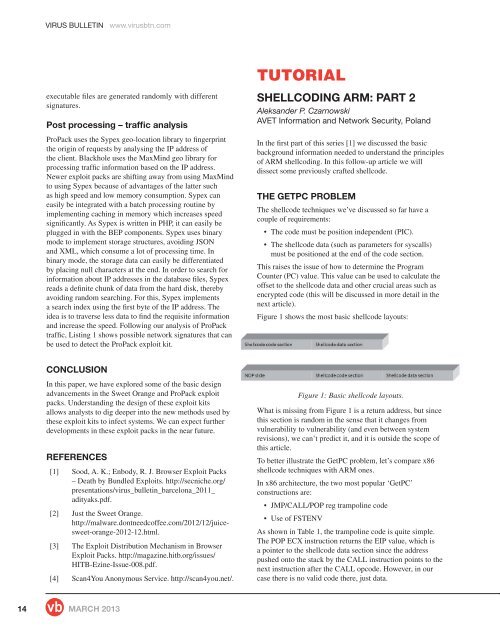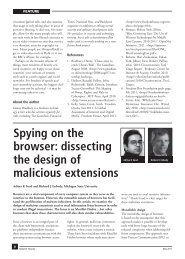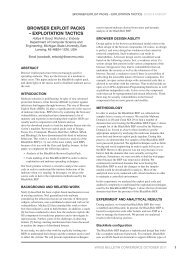Sweet Orange Exploit Pack Design Analysis - SecNiche Security Labs
Sweet Orange Exploit Pack Design Analysis - SecNiche Security Labs
Sweet Orange Exploit Pack Design Analysis - SecNiche Security Labs
You also want an ePaper? Increase the reach of your titles
YUMPU automatically turns print PDFs into web optimized ePapers that Google loves.
VIRUS BULLETIN www.virusbtn.com<br />
TUTORIAL<br />
executable files are generated randomly with different<br />
signatures.<br />
Post processing – traffic analysis<br />
Pro<strong>Pack</strong> uses the Sypex geo-location library to fingerprint<br />
the origin of requests by analysing the IP address of<br />
the client. Blackhole uses the MaxMind geo library for<br />
processing traffic information based on the IP address.<br />
Newer exploit packs are shifting away from using MaxMind<br />
to using Sypex because of advantages of the latter such<br />
as high speed and low memory consumption. Sypex can<br />
easily be integrated with a batch processing routine by<br />
implementing caching in memory which increases speed<br />
significantly. As Sypex is written in PHP, it can easily be<br />
plugged in with the BEP components. Sypex uses binary<br />
mode to implement storage structures, avoiding JSON<br />
and XML, which consume a lot of processing time. In<br />
binary mode, the storage data can easily be differentiated<br />
by placing null characters at the end. In order to search for<br />
information about IP addresses in the database files, Sypex<br />
reads a definite chunk of data from the hard disk, thereby<br />
avoiding random searching. For this, Sypex implements<br />
a search index using the first byte of the IP address. The<br />
idea is to traverse less data to find the requisite information<br />
and increase the speed. Following our analysis of Pro<strong>Pack</strong><br />
traffic, Listing 1 shows possible network signatures that can<br />
be used to detect the Pro<strong>Pack</strong> exploit kit.<br />
SHELLCODING ARM: PART 2<br />
Aleksander P. Czarnowski<br />
AVET Information and Network <strong>Security</strong>, Poland<br />
In the first part of this series [1] we discussed the basic<br />
background information needed to understand the principles<br />
of ARM shellcoding. In this follow-up article we will<br />
dissect some previously crafted shellcode.<br />
THE GETPC PROBLEM<br />
The shellcode techniques we’ve discussed so far have a<br />
couple of requirements:<br />
• The code must be position independent (PIC).<br />
• The shellcode data (such as parameters for syscalls)<br />
must be positioned at the end of the code section.<br />
This raises the issue of how to determine the Program<br />
Counter (PC) value. This value can be used to calculate the<br />
offset to the shellcode data and other crucial areas such as<br />
encrypted code (this will be discussed in more detail in the<br />
next article).<br />
Figure 1 shows the most basic shellcode layouts:<br />
CONCLUSION<br />
In this paper, we have explored some of the basic design<br />
advancements in the <strong>Sweet</strong> <strong>Orange</strong> and Pro<strong>Pack</strong> exploit<br />
packs. Understanding the design of these exploit kits<br />
allows analysts to dig deeper into the new methods used by<br />
these exploit kits to infect systems. We can expect further<br />
developments in these exploit packs in the near future.<br />
REFERENCES<br />
[1] Sood, A. K.; Enbody, R. J. Browser <strong>Exploit</strong> <strong>Pack</strong>s<br />
– Death by Bundled <strong>Exploit</strong>s. http://secniche.org/<br />
presentations/virus_bulletin_barcelona_2011_<br />
adityaks.pdf.<br />
[2] Just the <strong>Sweet</strong> <strong>Orange</strong>.<br />
http://malware.dontneedcoffee.com/2012/12/juicesweet-orange-2012-12.html.<br />
[3] The <strong>Exploit</strong> Distribution Mechanism in Browser<br />
<strong>Exploit</strong> <strong>Pack</strong>s. http://magazine.hitb.org/issues/<br />
HITB-Ezine-Issue-008.pdf.<br />
[4] Scan4You Anonymous Service. http://scan4you.net/.<br />
Figure 1: Basic shellcode layouts.<br />
What is missing from Figure 1 is a return address, but since<br />
this section is random in the sense that it changes from<br />
vulnerability to vulnerability (and even between system<br />
revisions), we can’t predict it, and it is outside the scope of<br />
this article.<br />
To better illustrate the GetPC problem, let’s compare x86<br />
shellcode techniques with ARM ones.<br />
In x86 architecture, the two most popular ‘GetPC’<br />
constructions are:<br />
• JMP/CALL/POP reg trampoline code<br />
• Use of FSTENV<br />
As shown in Table 1, the trampoline code is quite simple.<br />
The POP ECX instruction returns the EIP value, which is<br />
a pointer to the shellcode data section since the address<br />
pushed onto the stack by the CALL instruction points to the<br />
next instruction after the CALL opcode. However, in our<br />
case there is no valid code there, just data.<br />
14 MARCH 2013












